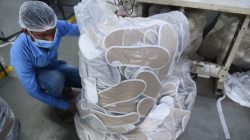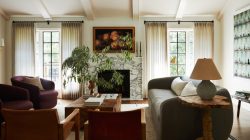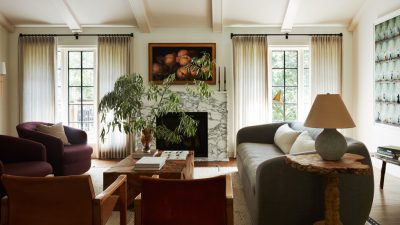This article is part of our Design special report previewing Milan Design Week.
Designers are by definition manipulators — of materials, senses and expectations. There is nothing they like better than making the beholders of their creations stop in their tracks. At the Salone del Mobile, in a show devoted to emerging designers that runs through Sunday, visitors may be arrested by a cushion that resembles a big colorful, softball and sits like an egg in a nest of polished wood sticks. What is it? An ottoman, naturally. A few other eye catchers and head scratchers are presented below.
Another Approach to Seating
After studying industrial design at the University of Notre Dame, Ryan Twardzik tried his hand at footwear, accessory and graphic design. But “all I wanted to do was furniture,” he recalled. Moving to Schuylkill County, in Pennsylvania, in 2021, he had access to local manufacturers, including a metal fabricator who primarily built roller coasters. That led to his furniture company, Unform Studio, and its debut collection, Drip, a series of fluoro-colored chairs formed of bent metal sheeting. “I want to make things that are not just fun to look at, but also fun to touch and interact with,” he said.
Mr. Twardzik is showing works from two new collections at SaloneSatellite, the presentation of young designers that runs concurrently with the Salone del Mobile. The first, Spherae, is a ball-shaped cushion supported by three polished wood dowels that slide through a brass disc and lock into place.
“I’ve been calling it passive joinery,” Mr. Twardzik said, because the construction, inspired by foldable camping chairs, does not require tools for assembly. The stool or ottoman comes with four different cushions resembling giant, fruit-toned softballs that can be swapped out. “You can just pop whichever color you want on there,” he said, “and the other three live around the piece.”
The designer is also showing an armchair from his Pop-Up collection. Formed of 20 metal posts wrapped in upholstered foam cylinders, it functions loosely like a soft-touch bed of nails. “They pop up at different heights. Some to arm and back height and some to a shorter seat height,” he said about the components. The experiments, he added, are far from over: “There are so many ways to explore how to make a chair.”
On view Tuesday through Sunday at Salone del Mobile, Pavilion 5, Booth C17; unformstudio.com. — LAURA MAY TODD
Exploring the Sound of Color
Last year at peak times, visitors to “Shaped by Water” — Google’s Milan Design Week offering — stood in line for up to two and a half hours to be admitted.
Inside the exhibition, they experienced light and sound waves passing through water in humming, resonant bowls (some visitors started hugging them), and a planetarium-style music and light show. “We had some people coming back three and four times,” said Ivy Ross, Google’s vice president of hardware design, who oversaw the project.
Now Google is switching elements with a celebration of color, partnering with the California arts and research lab Chromasonic to create the installation “Making Sense of Color.”
Thanks to Chromasonic’s technology, which translates light waves into sound and sound waves into light, visitors who pass through “Sensory Field” — 21 spaces at the beginning of the installation separated by translucent scrims — are able to “hear” the visible spectrum, in the form of shifting melodic tones.
Johannes Girardoni, a founder of Chromasonic, said this experience creates “an atmosphere in which physical space appears infinite, at other times enveloping.”
Elsewhere in the exhibition the design team has unpacked how color feels and what it tastes and smells like. The final space presents a tableau of Google products in different colors, like the Google Pixel Watch 2 and the Pixel phone.
“It’s kind of a reveal that brings it all together,” Ms. Ross said.
She added that she hopes visitors will gain a new appreciation for color’s many dimensions. “After having the experience of what does it sound like, feel like, taste like, look like,” she said, “they’ll never look at color the same way.”
On view Tuesday through Sunday at Garage 21, Via Archimede, 26. — MEGAN McCREA
Let There Be Light
The lighting designer Volker Haug and his team have partnered with the architects at Flack Studio to create Me and You, 13 decorative lighting fixtures that have nothing to do with a dog named Boo.
The collaboration between studios, both in Melbourne, Australia, grew out of a mishap. Last year, a vintage wall sconce was being installed in a private residence designed by Flack Studio when the glass broke. Replacing the lamp meant refinishing the wall behind it, and there was no time for that. So David Flack, the firm’s founder, asked Mr. Haug, a longtime acquaintance, to create a new sconce for the square metal wall plate that was already in place.
The success of the ad hoc solution “inspired us to go, ‘Ooh, what else could we do?’” Mr. Haug recalled in a phone call from Melbourne.
The men began knocking out other ideas for lamps based on metal squares, but soon their designs “started getting longer and skinnier, or smaller or rounder,” Mr. Haug said.
The lamp called Bruce is closer to the original conception. First designed by Flack Studio for the Ace Hotel in Sydney, it was revised by the collaborators as a boxy, cast-brass grid laid over textured, glowing glass, which gives it some opacity, “like a bathroom window,” Mr. Haug said. A linear version — a single row of squares — has just been added to the collection.
Me and You can be seen Tuesday through Sunday at Via San Maurilio, 18; volkerhaug.com and flack.studio. — JULIE LASKY
Using Older Spaces for New Talent
Lionel Jadot, a Belgian designer and architect, is partial to retrofitting old manufacturing buildings. His own company, Zaventem Ateliers, occupies a 6,000-square-meter (64,583 square foot) 19th-century paper factory near Brussels. During Milan Design Week he is again transforming a run-down industrial site into a showcase for young talent.
He has organized a display of furniture, lighting, textiles and sculpture by more than 30 designers, studios and artists — mostly from Belgium but also a handful from other countries. All these works are presented in a 7,300-square-meter (78,577-square-foot) 1950s industrial building in the Baranzate municipality northwest of central Milan, under the name Baranzate Ateliers, its second appearance at Design Week.
“I’m part of a family of makers since six generations,” Mr. Jadot said. “I know what a struggle it is to be in your workshop, to try to produce, to try to connect with people, to create collaboration.”
Many of the pieces straddle the line between furniture and sculpture. Mircea Anghel, a designer in Lisbon, makes tables and chairs from rough stones and polished wood. Studio Élémentaires in Belgium combines bits of the urban fabric (aluminum, motors, reflective filters) with LEDs to create kinetic lighting. KRJST Studio in Belgium weaves tapestries with “the monstrous creatures that haunt our dreams, not as external threats, but rather as mirrors of our own dark side,” said Justine de Moriamé, a founder with Erika Schillebeeckx of the studio, which is displaying examples of such work, including the hanging called Kappa.
The tapestries are inspired by the phenomenon of pareidolia, or the tendency to see shapes or make pictures out of randomness. “It is these harmonious or chaotic reveries that form the basis of our imaginations and personal mythologies,” Ms. Schillebeeckx added.
Baranzate Ateliers is on view Monday through Sunday at Via Gaudenzio Fantoli 16/3; baranzateateliers.com. — STEPHEN TREFFINGER
Sumber: www.nytimes.com












